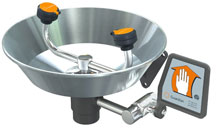



Find all of your laboratory and workplace safety supplies at Safety Emporium!
 Spasm |
 Glossary Index |
 Sternutator |
| MSDS Topics |
Free Sites | FAQ's | Regulations | Glossary | Software | Suppliers |
| Books | Forum | Poll | Fun stuff | Quiz | Store | |
| Understand your MSDS with the MS-Demystifier | Search ALL our MSDS info | |||||

Get your PPE such as made in USA NIOSH-approved N95 masks from Safety Emporium.
A Short Term Exposure Limit (STEL) is defined by ACGIH as the concentration to which workers can be exposed continuously for a short period of time without suffering from:
STEL's are generally used only when toxic effects have been reported from high acute (short-term) exposures in either humans or animals. An STEL is not a separate independent exposure limit, but supplements time-weighted average limits where there are recognized acute effects from a substance whose toxic effects generally chronic (long-term) in nature.
For example, one can not be exposed to an STEL concentration if the TLV-TWA (time weighted average for an 8 hour shift; see Permissible Exposure Limit (PEL)) would be exceeded. Workers can be exposed to a maximum of four STEL periods per 8 hour shift, with at least 60 minutes between exposure periods.
NOTE: We may collect a share of sales or other compensation from the links in the following list:
PEL's and TLV-STEL's (if they exist) are required in Section 8 (exposure controls/personal protection) of a Safety Data Sheet. These values are usually found for substances that may be inhaled, although some can be absorbed through the skin or eyes (STEL's will often have "-skin" after them when skin exposure is possible). When working with materials that have listed exposure limits, use proper precautions to minimize the generation of a vapor or dust in the first place. Always use appropriate personal protective equipment (PPE) such as gloves, dust masks, and respirators to limit your exposure to chemicals.
Remember, exposure limits are not some magic threshold that define the border between safe and dangerous. A PEL or STEL that was acceptable in 1950 may be recognized as dangerously high today. Therefore, always do everything reasonable to limit the airborne release of chemicals or dusts in the first place.

Safety Emporium carries all kinds of eye/face washes, safety showers, drench hoses and more.
See also: PEL and TWA, Threshold Limit Values (TLV)
Additional definitions from Google and OneLook.
Entry last updated: Monday, January 16, 2023. This page is copyright 2000-2025 by ILPI. Unauthorized duplication or posting on other web sites is expressly prohibited. Send suggestions, comments, and new entry desires (include the URL if applicable) to us by email.
Disclaimer: The information contained herein is believed to be true and accurate, however ILPI makes no guarantees concerning the veracity of any statement. Use of any information on this page is at the reader's own risk. ILPI strongly encourages the reader to consult the appropriate local, state and federal agencies concerning the matters discussed herein.